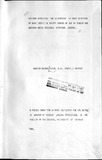| dc.description.abstract | The variation of body weights of 718 beef cattle was examined using data from 1969 to 1974 at Kiboko and Buchuma Range Research Stations which are located in the arid and
semi-arid zone. The Least Squares Method of fitting constants for non-orthogonal data was used to estimate the effect of genotype, age of dam, season of birth, year of birth, sex, place of birth, weaning weight and some two-way interactions of the main effects on the weights of beef cattle.
The genotypes analysed included East African Shorthorn Zebu (EASZ), Sahiwal x EASZ, Boran x EASZ, Sahiwal, Boran, Friesian x Sahiwal and Friesian x Baran. In the first
analysis data from Kiboko and Buchuma were analysed and only th~ee genotypes, namely Sahiwal, Friesian x Sahiwal and Friesian x Baran were included in the model. The corrected mean body weight obtained was 322.46 ± 48.14 kg. In the secane analysis only Kiboko data were analysed and all seven genotypes were included in the model. The corrected mean body weight obtained was 281.97 ± 53.75 kg.
Weaning weight, genotype, season of birth, year of birth, place of birth and sex had significant effects on the weight analysed together with some two way interactions. The
weaning weight and the year of birth contributed 15.17% and 15.95% to the total variation in the first analysis and 10.51% and 17.41% in the second analysis, respectively.
The Sahiwal x EASZ and Boran x EASZ i'iere8,24 kg (3.23%) and 16.44 kg (6.44%) heavier than the EASZ respectively, The weights of the Sahiwal and the Boran, and their crosses with the Friesian were significantly heavier than those of the EASZ and its crosses with the Sahiwal and the Boran. Buchuma animals were 17.40 kg (5.50%) heavier than Kiboko animals.
The steers were 4.68 kg (1045%) and 9.68 kg (3.43%) heavier than the females in the first and second analyses respectively.
The most and least favourable years of birth were 1971 and 1973 respectively. In 1969 through 1973, Buchuma animals were heavier than Kiboko animals while the reverse was true for 1974. The performance of the genotypes varied from year to year and the ranking changes were found to be significant.
The most suitable season of birth for the Sahiwal, Baran and EASZ was the wet season while the end of the wet season was found most suitable for the Friesian x Sahiwal, Friesian x Baran and Baran x EASZ. The most suitable season of birth for the Sahiwal x EASZ was the dry season while the end of the dry season was the least favourable
season of birth for most of the genotypes.
A phenotypic correlation coefficient of 0.55 was found between weaning weight and the liveweight at 30 months. | en |

